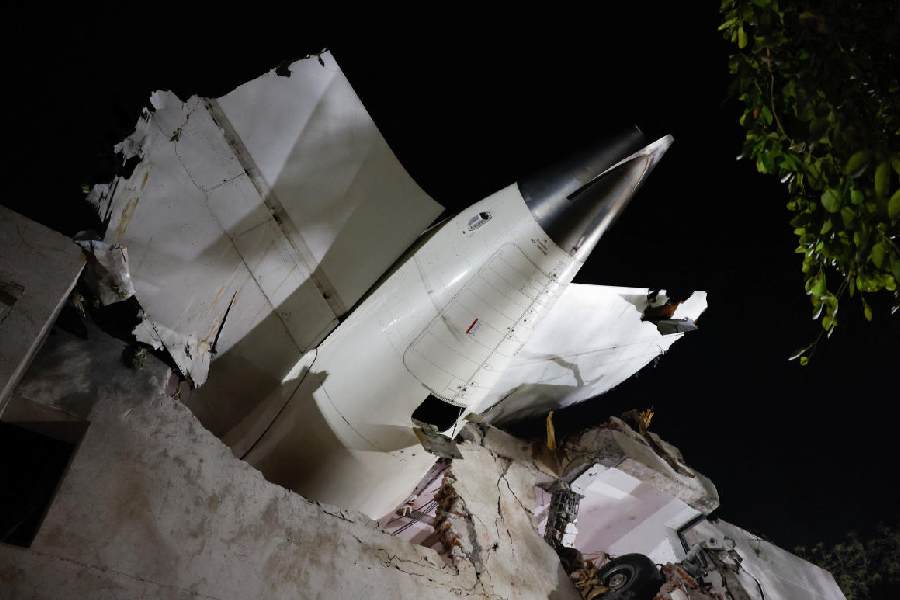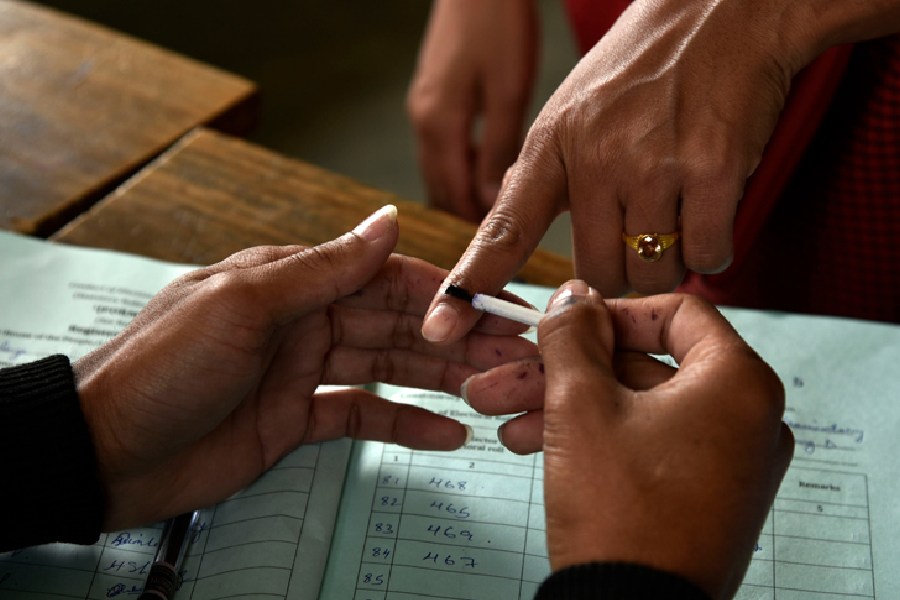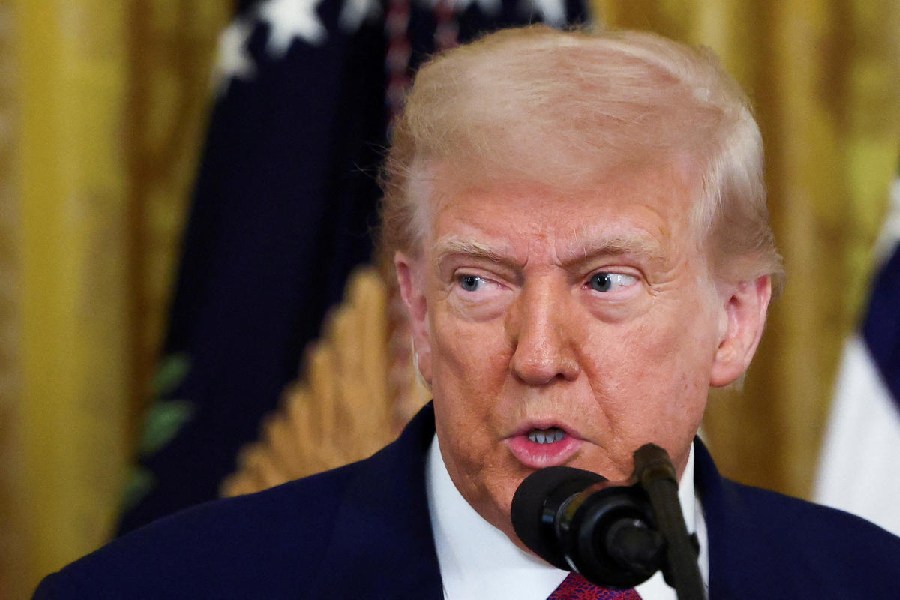The SMS came too late. Even before Professor V.S. Sridhar of Bangalore?s Vijaya College could erase the message ? ABVP plans to target you ? a group of 20 slogan-shouting students burst into his class, accused him of being a Naxalite supporter and beat him up with slippers. The reason: the English teacher, also a human rights activist, had criticised the killing of a Naxalite ideologue in a police encounter.
Strange though it may sound, the Right-wing student body, Akhil Bharatiya Vidyarthi Parishad, was merely feeding on Bangalore?s new found dread-of-the-Red. Last month, riots erupted in the city after a band of 200 armed Naxalites raided a Karnataka police camp ? firing from automatic weapons, hurling grenades and killing six policemen ? in the neighbouring Tumkur district. Since then, as Sridhar says, ?the fear of the Reds has entered urban consciousness?.
The foreboding is hardly misplaced. Last week an internal Bangalore police report named 200 Naxalite sympathisers based in India?s believed answer to the Silicon Valley. That?s not all. Slogans eulogising Nepal?s Maoists have appeared in the city?s localities such as Lalbagh West Gate. And recent Naxalite press releases have been issued from Jayanagar, an upscale south Bangalore colony.
Bangalore?s current state is the outcome of a fast and furious surge in radical Red extremism in India. Call them Left-wing extremists, radical Reds, good old Naxalites, or, by their latest name, the Maoists ? theirs is a riproaring advance from the boondocks to urban India.
Figures available with the New Delhi-based Institute for Conflict Management show that between November 2003, and September 2004, the Naxalite presence expanded from 55 districts in nine states to 156 districts in 13 states, an astounding average growth of two districts per week. By February 2005, statistics indicate, the number had further gone up to 170 districts in 15 states; thereby creating a Red corridor that connects eastern parts of India, including the Nepal Maoists, to the deep south. As Ajai Sahni, executive director of the institute, puts it, ?India Shining is coming under increasing threat from the Reds. And the government can only ignore it at its own peril.?
Arrests made from Hyderabad, Patna and Nagpur (see box) and the recent developments in Bangalore bolster this view. Traditionally, the Naxalites have used the urban centres as hideouts and for logistical support. Now, says Sanjay K. Jha of the Institute for Defence Studies and Analyses in New Delhi, urban areas are also being used as transit routes for arms and for mobilisation work. ?The arrest of Nepal Maoists from Indian cities indicates that the Naxalites from both countries are working in collaboration,? says Jha.
Even Maoists admit to their rising ambitions. In an interview last year, a top Andhra Pradesh-based Naxalite leader admitted to the party preparing a document on working in cities.
The changed strategy can be attributed to the September 2004 merger of Communist Party of India (Marxist-Leninist) (People?s War) and Maoist Communist Centre of India (MCCI) ? the two parties which roughly account for about 90 per cent of the country?s Left extremists ? into a united Communist Party of India (Maoists). ?Even the Centre admits there is a parallel government in 12 states,? says an upbeat middle-level Maoist leader on phone from Dhanbad in Jharkhand. ?We are surrounding the cities first as per Maoist principles. Capturing them is the last part.?
The present state of Ranchi is a case in point. While Capitol Hill, the town?s new, swank hotel serves the finest grilled chicken forestiers dipped in red wine sauce, the Jharkhand capital is encircled by Naxalite-controlled districts. The radical Left is present in each of the 10 Jharkhand districts surrounding Ranchi.
And it?s affecting the region?s economy. Businessman Girish Malhotra explains how the Naxals have changed the entrepreneur mentality. ?Everybody wants to set up his industry within Ranchi?s 20-kilometre radius,? says Malhotra, president of the Federation of Jharkhand Chambers of Commerce and Industries. ?In fact, no new industry has come up in districts such as Palamau and Lohardaga during the past 10 years.?
In Orissa?s Malkangiri district, bank manager Chaturbhuj Das points out how the local economy shrinks in such conditions. Loan recovery, he says, has gone down dramatically because officers cannot move freely. Now the bad debt in his Kalimela branch is a sky-high Rs 35 lakh. ?The bank is wary of giving new loans,? he says.
Top police officials as well as senior bureaucrats insist that the Naxalites are nothing more than extortionists. The truth is far more complex.
Local journalists as well as NGOs working in the area believe that the jan adalats (informal public courts) have gone a long way in creating and expanding the Maoists? social base. The system of instant justice at no cost is a raging success with the underprivileged. Even a Jharkhand state document points out that developmental activities such as setting up schools and building small earthen dams are part of their strategies. In their areas of control, the Maoists ensure better attendance of government school teachers and doctors. ?At that level, their intervention has ensured that the state delivery mechanism improves,? says Ranchi-based journalist Sudhir Pal.
The Naxalites are not short of cash. In 2003, Jharkhand police seized Rs 36 lakh during raids on Naxal hideouts. ?We charge a levy,? says the Maoist. Government contractors and those making money from forests and mines are charged the unofficial tax ? ranging from two to 20 per cent. Says Ganesh Chandra Modal, a BJP leader in Malkangiri, ?The Maoists say they need money to run the dalams (groups).?
Internal security experts note that the Maoists are now displaying an increasing maturity in dealing with the system and wresting the maximum out of it without compromising on their long-term goal of overthrowing the state. For instance, whenever a particular state government gets rough, they secretly join hands with the Opposition. Sahni believes that the Congress cut a covert deal with the Reds in Andhra Pradesh. And not everybody believes Jharkhand home secretary J.B. Tubid when he says that the rise in voting percentage from 30-35 per cent to 55 per cent during the recent state Assembly polls is a sign of the dwindling influence of the Maoists. ?The increase is because the Maoists have ensured the victory of candidates better inclined to them,? says a human rights activist.
The great Red spread is primariliy happening in areas contiguous to Andhra Pradesh, Bihar, Jharkhand and Chhattisgarh ? four states where the armed, radical Left has been traditionally strong. As police and paramilitary forces turned on the squeeze, the Naxalites moved into the quieter states, later building bases there. For instance, AP Naxalites on the run used the forests of Orissa?s Koraput and Malkangiri and Maharashtra?s Gadchiroli district. Now, these districts too have a strong Naxal presence. In Koraput district headquarters, even the police armoury was attacked last year.
States such as Jharkhand have invested heavily in the police. Though 30 paramilitary companies were stationed in the state for the past three years, some 15,000 constables, recruited in the past one year, are being trained by the army. The armed police will now carry self-loading rifles, an improvement from the earlier 303 rifles, alongwith mine detectors and night vision devices. Ironically, even the Maoists are modernising their armed units.
Orissa, while modernising its police force, has also offered the olive branch. To win over the tribals ? the Maoists? primary constituency ? the state has withdrawn 34 cases involving 417 tribals. It has also retracted six serious cases involving Naxalites. ?We have done our bit, now let them come forward,? says B.B. Mishra, director-general of Orissa police. Insists Orissa home secretary Santosh Kumar, ?Development is the ultimate solution.?
Yet, the Naxalites have grown in both states as elsewhere. Bangalore police records show that in Karnataka the number of core Naxalites has shot up from 25 to 600 in the last six months. Such a rapid rise has prompted internal security experts to believe that Naxalism presents India?s most serious constitutional threat. Most armed movements such as those in Kashmir and in the Northeast are restricted to a single state. ?How will the government curtail a fluid, armed, organised movement cutting across 15 states?? asks Sahni.
Senior bureaucrats too feel that the Naxalites are a national problem and only a comprehensive all-India strategy can counter it. And, though, Prime Minister Manmohan Singh last month noted that Left extremism had gained pace in areas where much of India?s minerals and hydro-electric projects are located, no major initiative seems to be in the offing.
Till then, the Maoists continue to consolidate and multiply in the hinterland and encircle the cities. Manjushree Thapa writes in Forget Kathmandu about the elite in the Nepal capital living in dread of a final assault from the Maoists. However unlikely that may seem at the moment, the CPI (Maoists) hope to be in a similar position one day.
Keeping to the left
• Red Heat: Lal Salaam (2002), Bollywood’s boorish take on the Naxalites, collapsed at the box office everywhere. Except Bihar where the film ran to packed houses in towns like Patna and Buxar. Reason: the People’s War Group unofficially adopted the movie as part of its cultural promotion package and encouraged its supporters and sympathisers to watch the Nandita Das-Sharad Kapoor starrer. Lal Salaam’s pirated copies were even shown in remote villages by the Naxalite outfit.
• Running scared: After Left-wing extremists attacked the Kalimela and Motu police stations in Orissa’s Malkangiri district in August 2001, security forces launched a massive combing operation. Not to look for the ultras but to locate the district collector and superintendent of police who had gone missing. They were eventually found in a safe house in the neighbouring Koraput district. The officials said they had fled after word spread that their houses were the next targets.
• The Gunrunners: In January 2005, Mumbai’s anti-terrorist squad arrested two gunrunners of the Chhota Rajan gang after a dramatic car chase and seized a US-made Ruger revolver and five rounds of ammunitions. Investigations showed that the gangsters had procured the weapons from an arms consignment originally meant for Maoist insurgents in Nepal.











